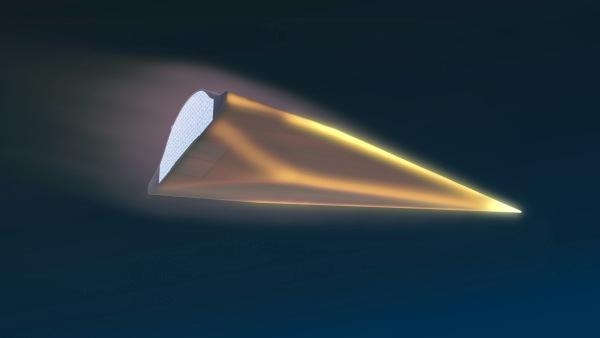Wed, Aug 24, 2011
Flight 1 Engineering Changes Believed Effective
During a test flight Thursday, 11 August, DARPA's Falcon HTV-2
scramjet powered aircraft experienced a flight anomaly post perigee
and into the vehicle's climb. The anomaly prompted the vehicle's
autonomous flight safety system to use the craft's aerodynamic
systems to make a controlled descent and splash down into the
ocean, according to a DARPA news release. Controlled descent is a
term typically associated with a human-in-the-loop directing or
guiding the unscheduled landing of an aircraft. For DARPA's
Hypersonic Technology Vehicle 2 (HTV-2) controlled descent takes on
new meaning thanks to the vehicle's safety system.

"We've confirmed that the HTV-2 made impact with the Pacific
Ocean along its flight trajectory as planned in the event of an
anomaly," explained Air Force Maj. Chris Schulz, DARPA HTV-2
program manager and PhD in aerospace engineering. "This flight
safety system is a significant engineering advance in that the
system prompts a vehicle to monitor the parameters under which it
is operating and exercise safety protocols completely autonomously
should those parameters be breached."
"According to a preliminary review of the data collected prior
to the anomaly encountered by the HTV-2 during its second test
flight," said DARPA Director Regina Dugan, "HTV-2 demonstrated
stable aerodynamically controlled Mach 20 hypersonic flight for
approximately three minutes. It appears that the engineering
changes put into place following the vehicle's first flight test in
April 2010 were effective. We do not yet know the cause of the
anomaly for Flight 2."
A detailed analysis conducted by an independent Engineering
Review Board following the first flight test, prompted engineers to
adjust the vehicle's center of gravity, decrease the angle of
attack flown and use the onboard reaction control systems to
augment vehicle flaps during the vehicle's second flight test.
Those changes appear to have been effective. "An initial assessment
indicates," said Schulz, "that the Flight 2 anomaly is unrelated to
the Flight 1 anomaly."
More News
Aero Linx: JAARS Nearly 1.5 billion people, using more than 5,500 languages, do not have a full Bible in their first language. Many of these people live in the most remote parts of>[...]
'Airplane Bounced Twice On The Grass Runway, Resulting In The Nose Wheel Separating From The Airplane...' Analysis: The pilot reported, “upon touchdown, the plane jumped back>[...]
"Burt is best known to the public for his historic designs of SpaceShipOne, Voyager, and GlobalFlyer, but for EAA members and aviation aficionados, his unique concepts began more t>[...]
"Polaris Dawn, the first of the program’s three human spaceflight missions, is targeted to launch to orbit no earlier than summer 2024. During the five-day mission, the crew >[...]
There Are SO Many Ways To Get YOUR Aero-News! It’s been a while since we have reminded everyone about all the ways we offer your daily dose of aviation news on-the-go...so he>[...]
 ANN's Daily Aero-Linx (05.04.24)
ANN's Daily Aero-Linx (05.04.24) NTSB Final Report: Quest Aircraft Co Inc Kodiak 100
NTSB Final Report: Quest Aircraft Co Inc Kodiak 100 Aero-News: Quote of the Day (05.04.24)
Aero-News: Quote of the Day (05.04.24) Aero-News: Quote of the Day (05.05.24)
Aero-News: Quote of the Day (05.05.24) Read/Watch/Listen... ANN Does It All
Read/Watch/Listen... ANN Does It All



